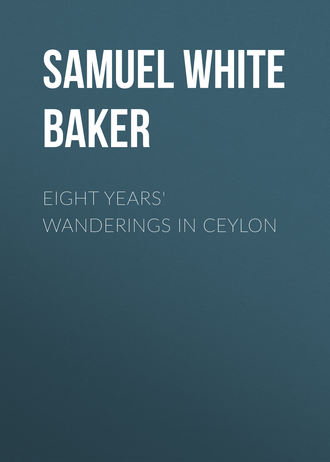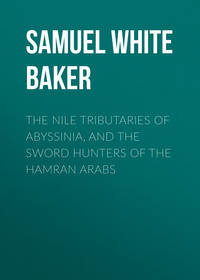 полная версия
полная версияEight Years' Wanderings in Ceylon
Nine miles to the east of Newera Ellia, at a lower elevation of one thousand five hundred feet, stretches the Ouva country, forming the fourth ledge.
The features of this country are totally distinct from any other portion of Ceylon. A magnificent view extends as far as the horizon, of undulating open grassland, diversified by the rich crops of paddy which are grown in each of the innumerable small valleys formed by the undulations of the ground. Not a tree is to be seen except the low brushwood which is scantily distributed upon its surface. We emerge suddenly from the forest-covered mountains of Newera Ellia, and, from a lofty point on the high road to Badulla, we look down upon the splendid panorama stretched like a waving sea beneath our feet. The road upon which we stand is scarped out of the mountain's side. The forest has ceased, dying off gradually into isolated patches and long ribbon-like strips on the sides of the mountain, upon which rich grass is growing, in vivid contrast to the rank and coarse herbage of Newera Ellia, distant only five miles from the point upon which we stand.
Descending until we reach Wilson's Plain, nine miles from Newera Ellia, we arrive in the district of Ouva, much like the Sussex Downs as any place to which it can be compared.
This district comprises about six hundred square miles, and forms the fourth and last ledge of the high lands of Ceylon. Passes from the mountains which form the wall-like boundaries of this table-land descend to the low country in various directions.
The whole of the Ouva district upon the one side, and of the Kotmalee district on the other side, of tilt Newera Ellia range of mountains, are, with the exception of the immediate neighborhood of Kandy and Colombo, the most populous districts of Ceylon.
This is entirely owing, to the never-failing supply of water obtained from the mountains; and upon this supply the wealth and prosperity of the country depend.
The ancient history of Ceylon is involved in much obscurity, but nevertheless we have sufficient data in the existing traces of its former population to form our opinions of the position and power which Ceylon occupied in the Eastern Hemisphere when England was in a state of barbarism. The wonderful remains of ancient cities, tanks and water-courses throughout the island all prove that the now desolate regions were tenanted by a multitude—not of savages, but of a race long since passed away, full of industry and intelligence.
Among the existing traces of former population few are more interesting than those in the vicinity of Newera Ellia.
Judging from the present supply of water required for the cultivation of a district containing a certain population, we can arrive at a tolerably correct idea of the former population by comparing the present supply of water with that formerly required.
Although the district of Ouva is at present well populated, and every hollow is taken advantage of for the cultivation of paddy, still the demand for water in proportion to the supply is comparatively small.
The system of irrigation has necessarily involved immense labor. For many miles the water is conducted from the mountains through dense forests, across ravines, round the steep sides of opposing hills, now leaping into a lower valley into a reservoir, from which it is again led through this arduous country until it at length reaches the land which it is destined to render fertile.
There has been a degree of engineering skill displayed in forming aqueducts through such formidable obstacles; the hills are lined out in every direction with these proofs of industry, and their winding course can be traced round the grassy sides of the steep mountains, while the paddy-fields are seen miles away in the valleys of Ouva stretched far beneath.
At least eight out of ten of these watercourses are dry, and the masonry required in the sudden angles of ravines, has, in most cases, fallen to decay. Even those water-courses still in existence are of the second class; small streams have been conducted from their original course, and these serve for the supply of the present population.
From the remains of deserted water-courses of the first class, it is evident that more than fifty times the volume of water was then required that is in use at present, and in the same ratio must have been the amount of population. In those days rivers were diverted from their natural channels; opposing hills were cut through, and the waters thus were led into another valley to join a stream flowing in, its natural bed, whose course, eventually obstructed by a dam, poured its accumulated waters into canals which branched to various localities. Not a river in those times flowed in vain. The hill-sides were terraced out in beautiful cultivation, which are now waving with wild vegetation and rank lemon grass. The remaining traces of stone walls point out the ancient boundaries far above the secluded valley now in cultivation.
The nation has vanished, and with it the industry and perseverance of the era.
We now arrive at the cause of the former importance of Newera Ellia, or the "Royal Plains."
It has been shown that the very existence of the population depended upon the supply of water, and that supply was obtained from the neighborhood of Newera Ellia. Therefore, a king in possession of Newera Ellia had the most complete command over his subjects; he could either give or withhold the supply of water at his pleasure, by allowing its free exit or by altering its course.
Thus, during rebellion, he could starve his people into submission, or lay waste the land in time of foreign invasion. I have seen in an impregnable position the traces of an ancient fort, evidently erected to defend the pass to the main water-course from the low country.
This gives us a faint clue to the probable cause of the disappearance of the nation.
In time of war or intestine commotion, the water may have been cut off from the low country, and the exterminating effects of famine may have laid the whole land desolate. It is, therefore, no longer a matter of astonishment that the present plain of Newera Ellia should have received its appellation of the "Royal Plain." In those days there was no very secure tenure to the throne, and by force alone could a king retain it. The more bloodthirsty and barbarous the tyrant, the more was he dreaded by the awe-stricken and trembling population. The power of such a weapon of annihilation as the command of the waters may be easily conceived as it invested a king with almost divine authority in the eyes of his subjects.
Now there is little doubt that the existence of precious gems at Newera Ellia may have been accidentally discovered in digging the numerous water-courses in the vicinity; there is, however, no doubt that at some former period the east end of the plain, called the "Vale of Rubies," constituted the royal "diggings." That the king of Kandy did not reside at Newera Ellia there is little wonder, as a monarch delighting in a temperature of 85 Fahrenheit would have regarded the climate of a mean temperature of 60 Fahrenheit as we should that of Nova Zembla.
We may take it for granted, therefore, that when the king came to Newera Ellia his visit had some object, and we presume that he came to look at the condition of his water-courses and to superintend the digging for precious stones; in the same manner that Ceylon governors of past years visited Arippo during the pearlfishing.
The "diggings" of the kings of Kandy must have been conducted on a most extensive scale. Not only has the Vale of Rubies been regularly turned up for many acres, but all the numerous plains in the vicinity are full of pits, some of very large size and of a depth varying from three to seventeen feet. The Newera Ellia Plain, the Moonstone Plain, the Kondapallé Plain, the Elk Plains, the Totapella Plains, the Horton Plains, the Bopatalava Plains, the Augara Plains (translated "the Diggings"), and many others extending over a surface of thirty miles, are all more or less studded by deep pits formed by the ancient searchers for gems, which in those days were a royal monopoly.
It is not to be supposed that the search for gems would have been thus persevered in unless it was found to be remunerative; but it is a curious fact that no Englishmen are ever to be seen at work at this employment. The natives would still continue the search, were they permitted, upon the "Vale of Rubies;" but I warned them off on purchasing the land; and I have several good specimens of gems which I have discovered by digging two feet beneath the surface.
The surface soil being of a light, peaty quality, the stones, from their greater gravity, lie beneath, mixed with a rounded quartz gravel, which in ages past must have been subjected to the action of running water. This quartz gravel, with its mixture of gems, rests upon a stiff white pipe-clay.
In this stratum of gravel an infinite number of small, and for the most part worthless, specimens of gems are found, consisting of sapphire, ruby, emerald, jacinth, tourmaline, chrysoberyl, zircon, cat's-eye, "moonstone," and "star-stone." Occasionally a stone of value rewards the patient digger; but, unless he thoroughly understands it, he is apt to pass over the gems of most value as pieces of ironstone.
The mineralogy of Ceylon has hitherto been little understood. It has often been suggested as the "Ophir" of the time of Solomon, and doubtless, from its production of gems, it might deserve the name.
It has hitherto been the opinion of most writers on Ceylon that the precious metals do not exist in the island; and Dr. Davy in his work makes an unqualified assertion to that effect. But from the discoveries recently made, I am of opinion that it exists in very large quantities in the mountainous districts of the island.
It is amusing to see the positive assertions of a clever man upset by a few uneducated sailors.
A few men of the latter class, who had been at the gold diggings both in California and Australia, happened to engage in a ship bound for Colombo. Upon arrival they obtained leave from the captain for a stroll on shore, and they took the road toward Kandy, and when about half-way it struck them, from the appearance of the rocks in the uneven bed of a river, called the Maha Oya, "that gold must exist in its sands." They had no geological reason for this opinion; but the river happened to be very like those in California in which they had been accustomed to find gold. They accordingly set to work with a tin pan to wash the sand, and to the astonishment of every one in Ceylon, and to the utter confusion of Dr. Davy's opinions, they actually discovered gold!
The quantity was small, but the men were very sanguine of success, and were making their preparations for working on a more extensive scale, when they were all prostrated by jungle fever—a guardian-spirit of the gold at Amberpussé, which will ever effectually protect it from Europeans.
They all returned to Colombo, and, when convalescent, they proceeded to Newera Ellia, naturally concluding that the gold which existed in dust in the rivers below must be washed down from the richer stores of the mountains.
Their first discovery of gold at Newera Ellia was on the 14th June, 1854, on the second day of their search in that locality. The first gold was found in the "Vale of Rubies."
I had advised them to make their first search in that spot for this reason: that, as the precious stones had there settled in the largest numbers, from their superior gravity, it was natural to conclude that, if gold should exist, it would, from its gravity, be somewhere below the precious stones or in their vicinity.
From the facility with which it has been discovered, it is impossible to form an opinion as to the quantity or the extent to which it will eventually be developed. It is equally impossible to predict the future discoveries which may be made of other minerals. It is well known that quicksilver was found at Cotta, six miles from Colombo, in the year 1797. It was in small quantities, and was neglected by the government, and no extended search was prosecuted. The present search for gold may bring to light mineral resources of Ceylon which have hitherto lain hidden.
The minerals proved to exist up to the present time are gold, quicksilver, plumbago and iron. The two latter are of the finest quality and in immense abundance. The rocks of Ceylon are primitive, consisting of granite, gneiss and quartz. Of these the two latter predominate. Dolomite also exists in large quantities up to an elevation of five thousand feet, but not beyond this height.
Plumbago is disseminated throughout the whole of both soil and rocks in Ceylon, and may be seen covering the surface in the drains by the road side, after a recent shower.
It is principally found at Ratnapoora and at Belligam, in large, detached kidney-shaped masses, from four to twenty feet below the surface. The cost of digging and the transport are the only expenses attending it, as the supply is inexhaustible. Its component parts are nineteen of carbon and one of iron.
It exists in such quantities, in the gneiss rocks that upon their decomposition it is seen in bright specks like silver throughout.
This gneiss rock, when in a peculiar stage of decomposition, has the appearance and consistency of yellow brick, speckled with plumbago. It exists in this state in immense masses, and forms a valuable buildingstone, as it can be cut with ease to any shape required, and, though soft when dug, it hardens by exposure to the air. It has also the valuable property of withstanding the greatest heat; and for furnace building it is superior to the best Stourbridge fire-bricks.
The finest quality of iron is found upon the mountains in various forms, from the small iron-stone gravel to large masses of many tons in weight protruding from the earth's surface.
So fine is that considered at Newera Ellia and the vicinity that the native blacksmiths have been accustomed from time immemorial to make periodical visits for the purpose of smelting the ore. The average specimens of this produce about eighty per cent. of pure metal, even by the coarse native process of smelting. The operations are as follows:
Having procured the desired amount of ore, it is rendered as small as possible by pounding with a hammer.
A platform is then built of clay, about six feet in length by three feet in height and width.
A small well is formed in the centre of the platform, about eighteen inches in depth and diameter, egg-shaped.
A few inches from the bottom of this well is an air-passage, connected with a pipe and bellows.
The well is then filled with alternate layers of charcoal and pulverized iron ore; the fire is lighted, and the process of smelting commences.
The bellows are formed of two inflated skins, like a double "bagpipe." Each foot of the "bellows-blower" is strapped to one skin, the pipes of the bellows being fixed in the air-hole of the blast. He then works the skins alternately by moving his feet up and down, being assisted in this treadmill kind of labor by the elasticity of two bamboos, of eight or ten feet in length, the butts of which, being firmly fixed in the ground, enable him to retain his balance by grasping one with either hand. From the yielding top of each bamboo, a string descends attached to either big toe; thus the downward pressure of each foot upon the bellows strains upon the bamboo top as a fish bears upon a fishing-rod, and the spring of the bamboo assists him in lifting up his leg. Without this assistance, it would be impossible to continue the exertion for the time required.
While the "bellows-blower" is thus getting up a blaze, another man attends upon the well, which he continues to feed alternately with fresh ore and a corresponding amount of charcoal, every now and then throwing in a handful of fine sand as a flux.
The return for a whole day's puffing and blowing will be about twenty pounds weight of badly-smelted iron. This is subsequently remelted, and is eventually worked up into hatchets, hoes, betel-crackers, etc., etc. being of a superior quality to the best Swedish iron.
If the native blacksmith were to value his time at only sixpence per diem from the day on which he first started for the mountains till the day that he returned from his iron-smelting expedition, he would find that his iron would have cost him rather a high price per hundredweight; and if he were to make the same calculation of the value of time, he would discover that by the time he had completed one axe he could have purchased ready made, for one-third the money, an English tool of superior manufacture. This, however, is not their style of calculation. Time has no value, according to their crude ideas; therefore, if they want an article, and can produce it without the actual outlay of cash, no matter how much time is expended, they will prefer that method of obtaining it.
Unfortunately, the expense of transit is so heavy from Newera Ellia to Colombo, that this valuable metal, like the fine timber of the forests, must remain useless.
CHAPTER IV
Poverty of Soil—Ceylon Sugar—Fatality of Climate—Supposed Fertility of Soil—Native Cultivation—Neglect of Rice Cultivation—Abandoned Reservoirs—Former Prosperity—Ruins of Cities—Pollanarua—The Great Dagoba—Architectural Relics—The Rock Temple—Destruction of Population—Neglected Capabilities—Suggestions for Increasing Population—Progress of Pestilence—Deserted Villages—Difficulties in the Cultivation of Rice—Division of Labor—Native Agriculture.
From the foregoing description, the reader will have inferred that Newera Ellia is a delightful place of residence, with a mean temperature of 60 Fahrenheit, abounding with beautiful views of mountain and plain and of boundless panoramas in the vicinity. He will also have discovered that, in addition to the healthiness of its climate, its natural resources are confined to its timber and mineral productions, as the soil is decidedly poor.
The appearance of the latter has deceived every one, especially the black soil of the patina, which my bailiff, on his first arrival declared to be excellent. Lord Torrington, who is well known as an agriculturist, was equally deceived. He was very confident in the opinion that "it only required draining to enable it to produce anything." The real fact is, that it is far inferior to the forest-land, and will not pay for the working.
Nevertheless, it is my decided opinion that the generality of the forest-land at Newera Ellia and the vicinity is superior to that in other parts of Ceylon.
There are necessarily rich lots every now end then in such a large extent as the surface of the low country; but these lots usually lie on the banks of rivers which have been subjected to inundations, and they are not fair samples of Ceylon soil. A river's bank or a valley's bottom must be tolerably good even in the poorest country.
The great proof of the general poverty of Ceylon is shown in the failure of every agricultural experiment in which a rich soil is required.
Cinnamon thrives; but why? It delights in a soil of quartz sand, in which nothing else would grow.
Cocoa-nut trees flourish for the same reason; sea air, a sandy soil and a dry subsoil are all that the cocoa-nut requires.
On the other hand, those tropical productions which require a strong soil invariably prove failures, and sugar, cotton, indigo, hemp and tobacco cannot possibly be cultivated with success.
Even on the alluvial soil upon the banks of rivers sugar does not pay the proprietor. The only sugar estate in the island that can keep its head above water is the Peredinia estate, within four miles of Kandy. This, again, lies upon the bank of the Mahawelli river, and it has also the advantage of a home market for its produce, as it supplies the interior of Ceylon at the rate of twenty-three shillings per cwt. upon the spot.
Any person who thoroughly understands the practical cultivation of the sugar-cane can tell the quality of sugar that will be produced by an examination of the soil. I am thoroughly convinced that no soil in Ceylon will produce a sample of fine, straw-colored, dry, bright, large-crystaled sugar. The finest sample ever produced of Ceylon sugar is a dull gray, and always moist, requiring a very large proportion of lime in the manufacture, without which it could neither be cleansed nor crystalized.
The sugar cane, to produce fine sugar, requires a rich, stiff, and very dry soil. In Ceylon, there is no such thing as a stiff soil existing. The alluvial soil upon the banks of rivers is adapted for the growth of cotton and tobacco, but not for the sugar-cane. In such light and moist alluvial soil the latter will grow to a great size, and will yield a large quantity of juice in which the saccharometer may stand well; but the degree of strength indicated will proceed from an immense proportion of mucilage, which will give much trouble in the cleansing during boiling; and the sugar produced must be wanting in dryness and fine color.
There are several rivers in Ceylon whose banks would produce good cotton and tobacco, especially those in the districts of Hambantotte and Batticaloa; such as the "Wallawé," the "Yallé river," the "Koombookanaar," etc.; but even here the good soil is very limited, lying on either bank for only a quarter of a mile in width. In addition to this, the unhealthiness of the climate is so great that I am convinced no European constitution could withstand it. Even the natives are decimated at certain seasons by the most virulent fevers and dysentery.
These diseases generally prevail to the greatest extent during the dry season. This district is particularly subject to severe droughts; months pass away without a drop of rain or a cloud upon the sky. Every pool and tank is dried up; the rivers forsake their banks, and a trifling stream trickles over the sandy bed. Thus all the rotten wood, dead leaves and putrid vegetation brought down by the torrent during the wet season are left upon the dried bed to infect the air with miasma.
This deadly climate would be an insurmountable obstacle to the success of estates. Even could managers be found to brave the danger, one season of sickness and death among the coolies would give the estate a name which would deprive it of all future supplies of labor.
Indigo is indigenous to Ceylon, but it is of an inferior quality, and an experiment made in its cultivation was a total failure.
In fact, nothing will permanently succeed in Ceylon soil without abundance of manure, with the exception of cinnamon and cocoa-nuts. Even the native gardens will not produce a tolerable sample of the common sweet potato without manure, a positive proof of the general poverty of the soil.
Nevertheless, Ceylon has had a character for fertility. Bennett, in his work entitled "Ceylon and its Capabilities," describes the island in the most florid terms, as "the most important and valuable of all the insular possessions of the imperial crown." Again he speaks of "its fertile soil, and indigenous vegetable productions," etc., etc. Again: "Ceylon, though comparatively but little known, is pre-eminent in natural resources." All this serves to mislead the public opinion. Agricultural experiments in a tropical country in a little garden highly manured may be very satisfactory and very amusing. Everything must necessarily come to perfection with great rapidity; but these experiments are no proof of what Ceylon will produce, and the popular idea of its fertility has been at length proved a delusion.
It is a dangerous thing for any man to sit down to "make" a book. If he has had personal experience, let him write a description of those subjects which he understands; but if he attempts to "make" a book, he must necessarily collect information from hearsay, when he will most probably gather some chaff with his grain.
Can any man, when describing the "fertility" of Ceylon, be aware that newly-cleared forest-land will only produce one crop of the miserable grain called korrakan? Can he understand why the greater portion of Ceylon is covered by dense thorny jungles? It is simply this—that the land is so desperately poor that it will only produce one crop, and thus an immense acreage is required for the support of a few inhabitants; thus, from ages past up to the present time, the natives have been continually felling fresh forest and deserting the last clearing, which has accordingly grown into a dense, thorny jungle, forming what are termed the "Chénars" of Ceylon.









